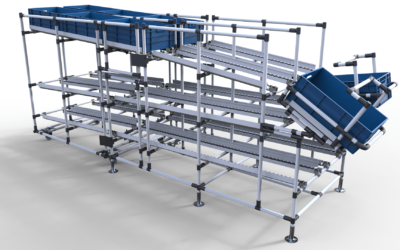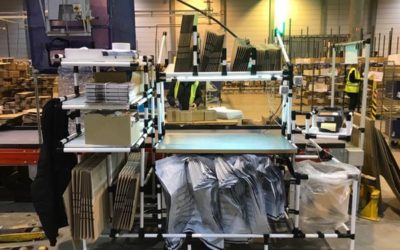Warehouse management challenges aren’t new, but with increasing consumer demand for e-commerce orders and accelerated shipment scheduling, they certainly feel more pressing these days. If you’re experiencing warehouse management challenges that you know are holding back your facility’s profitability, know that there are solutions available to you. Here’s a look at 5 of the most common warehouse management challenges and their solutions:
Warehouse Management Challenge #1: Lack of Space
In any warehouse, space is a challenge. From accommodating inventory to ensuring there is plenty of space for staff to pick, sort, and assemble, you’re only working with so much square footage. When you’re constantly receiving and accumulating stock, it can be difficult to establish an effective warehouse management system.
The solution: A well-managed warehouse starts with proper organization and storage.
It’s difficult to address any of the following challenges if you don’t first have an organized home and process for every product you manage.
The first step is to maximize the space you do have. Are you effectively using vertical space? Could you be storing and presenting materials more efficiently? Take a look at your warehouse, and how each product flows through the space. Do you notice inefficiencies? Sometimes, a solution as simple as implementing flow racks and re-organizing SKUs can open up a great deal of space.
Your smaller, high running materials present the greatest opportunity for a big and immediate impact with very minimal investment. Check out this article to see how a simple pallet racking adjustment helped one client achieve 170 additional pick faces, supporting new production while avoiding a costly warehouse expansion.
Warehouse Management Challenge #2: Inventory Accuracy and Tracking
When it comes to warehouse management, keeping a close, accurate eye on all of the products in your warehouse is a challenging but necessary task. One of the greatest inefficiencies a poorly managed warehouse can introduce is faulty inventory accuracy and tracking. If you don’t know how much you have of a product, how long you have had it, or where it is located, filling and packing orders is increasingly inefficient.
The solution: Have a plan for every part or product.
Known in the lean manufacturing world as PFEP or Plan for Every Part, this system is most often used in manufacturing facilities, but is equally as useful in solving warehouse management challenges, especially when it comes to inventory.
There is plenty of technical information on setting up a PFEP procedure if you’re looking for a how-to-guide. In short, it is very difficult to plan or improve a process you cannot see. The best thing you can do to get started is to take the time to consider each product’s life cycle as it flows into and out of your warehouse.
Where does each product come from? Where is the best place to store each product? How long will you have it in inventory? Will you perform any value-add service to that product while you have it? How can you start storing and stocking those products more intuitively?
Start small, and be sure to support your efforts with the solutions that work with you. Modular flow racks, packing stations, and picking carts can help you get those products exactly where they need to go while providing the flexibility you need to shift and adapt as you learn better how to store and keep track of your inventory.
Warehouse Management Challenge #3: Product Picking and Order Processing Inefficiencies
Product picking and order processing inefficiencies are an increasing challenge for warehouse management. Especially as e-commerce orders continue to soar, warehouses across the country are adapting to picking smaller orders on shorter return times. If you can optimize the product picking process, you stand to increase profitability by boosting the number of orders your warehouse can pick and ship in a shift or day.
The Solution: Consider “First In, First Out” or FIFO with Flow Racks
Especially for applications where products have a shelf life or expiration date, it’s essential to pick the oldest products in the warehouse first.
There is a range of lean solutions that can help support FIFO. From picking carts to organized flow racks, there are many tools you can implement in your warehouse to deliver products to pickers in a way that supports FIFO throughout your warehouse. Don’t address material flow in a single aspect. Where material comes from, where it needs to go, and the method of fulfilling this process are all aspects to consider as a material flow system.
Custom workstations are another ideal warehouse solution. Packaging and repackaging for order processing is a drain on profitability. When everything your operators need is within arms reach, and their workstations are organized according to their specific needs, you can improve process time and save space.
Warehouse Management Challenge #4: Product Handling Damages
When items are damaged or broken in the warehouse, those damages come right out of your facility’s bottom line. While some level of product handling damage is expected, minimizing it can go a long way to improve your facility’s returns. And minimizing product handling damages, for most applications, can be easier than you think.
The solution: Organization, proper storage, and material handling solutions that reduce damage.
The first step in minimizing product handling damages is to reduce product handling. This may seem elementary, but take the time to walk through the process (remember PFEP from earlier?) for each part, and see how many times it is touched while you own it, then look for opportunities to reduce handling. Then it is time to get organized. A poorly organized warehouse often means overloading shelves and racks, which can lead to significant damages.
Another solution is phasing out forklifts, which can cause a significant amount of damage when they are used improperly, or when pallets start to crack or break. By implementing better material delivery systems, like custom delivery carts made for the warehouse, which minimize product overhandling and repackaging, you reduce the potential for product damage.
Warehouse Management Challenge #5: Managing Fluctuations in Demand
In a recent market survey, changes in consumer demand were shown to be the biggest warehouse management challenge, primarily because it’s not a challenge you can predict or control. Changes in demand due to a shifting economy, extreme weather, and even seasonality of a product can change what your warehouse looks like in an instant. When consumer demand is constantly in flux, how can you adapt in a way that maintains your warehouse’s profitability?
The Solution: Lean material flow solutions that scale as your processes do.
If there’s one thing you know for sure about warehouse management, it’s that there are ebbs and flows to the demand for your products. The best solution to this common, but often difficult-to-solve warehouse management challenge is to invest in flexible lean material flow solutions that can adapt as quickly as demand increases or wanes.
One ideal solution for warehouses is customizable material handling carts. These modular, convertible material handling solutions are easily assembled and reassembled to suit any product or part in your warehouse. If implementing a new cart program, now is the time to standardize your cart platform, and use what we call a “Top Hat” system that can adapt quickly to a variety of changing needs.
You can apply the same methodology to any support component in your warehouse, from workstations to flow racks and even material delivery carts. When all of these solutions are designed upfront for flexibility — built from tube and joint assembly that is easy to break down or build up — reconfiguring your warehouse to suit changing consumer demand is simple.
While warehouse management challenges can feel overwhelming, and at times, insurmountable, it’s important to know that there are solutions. By taking a close look at how your warehouse operates, and by tackling small projects one at a time, you can address each of these warehouse management challenges to develop a new and improved warehouse that is streamlined, efficient, and profitable. For more information on any of the solutions to warehouse management challenges mentioned in this blog, contact the team at Geolean USA. We’re happy to answer any questions you have.





